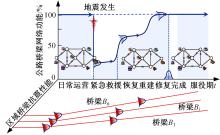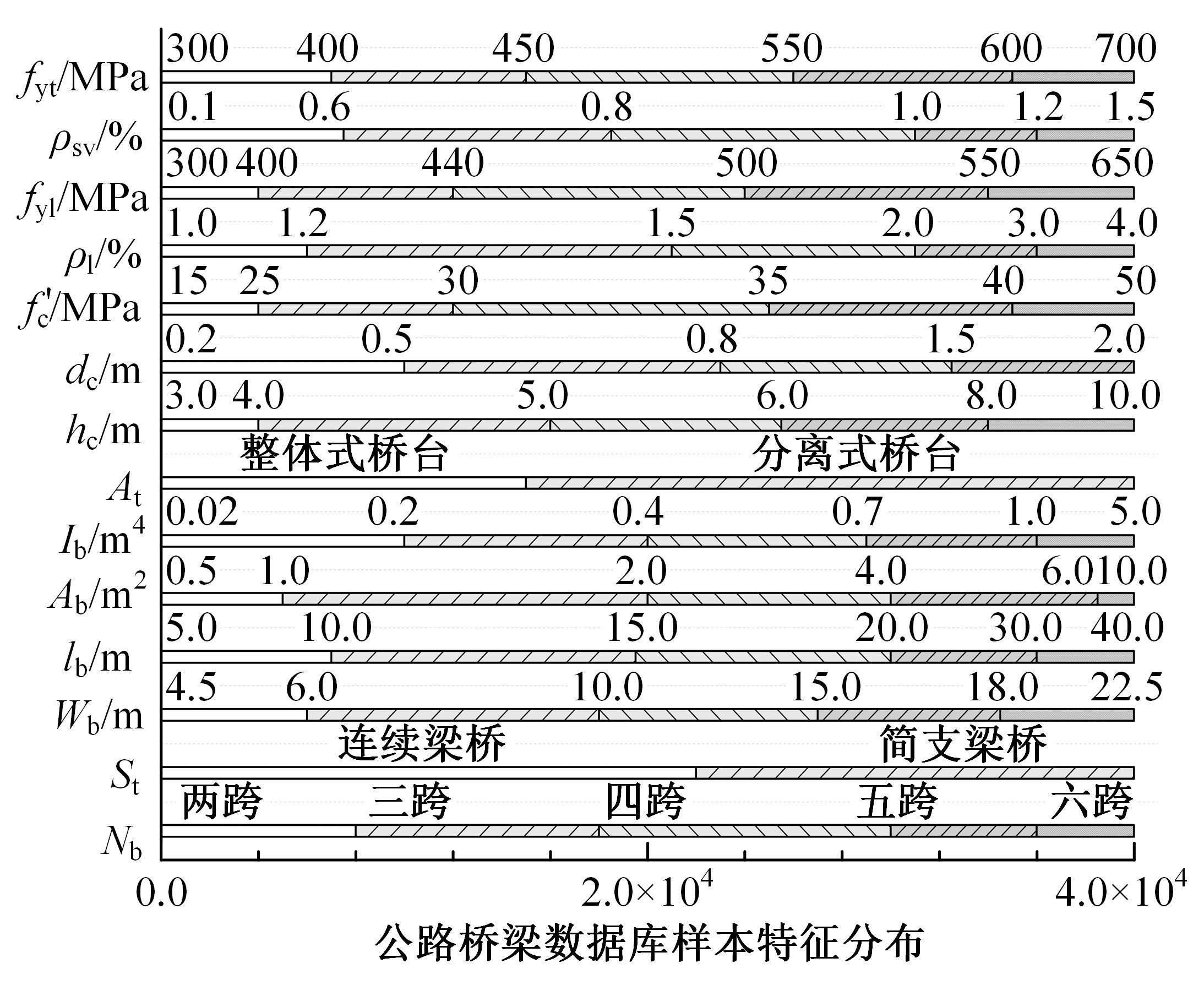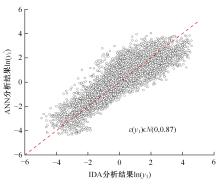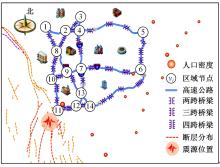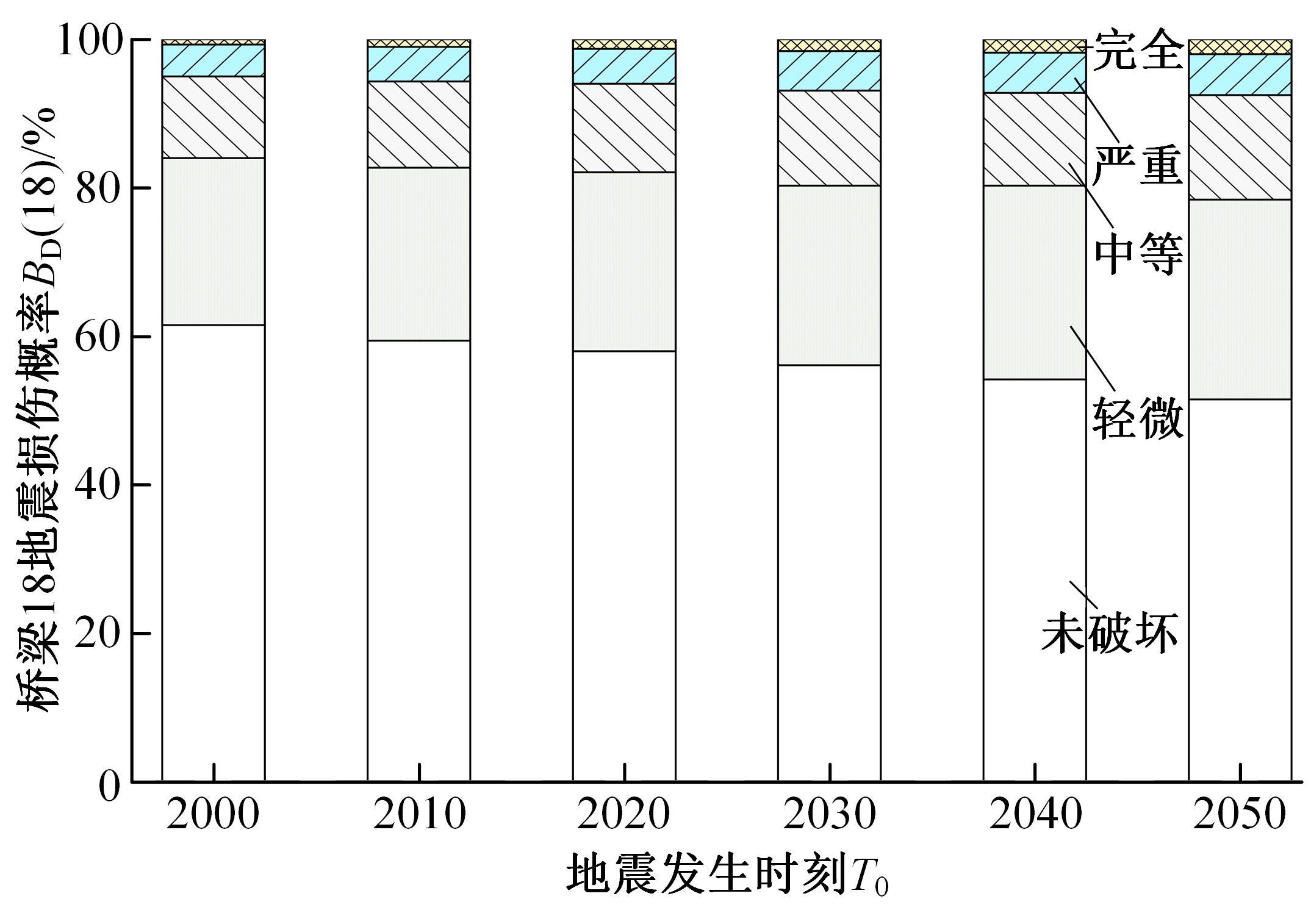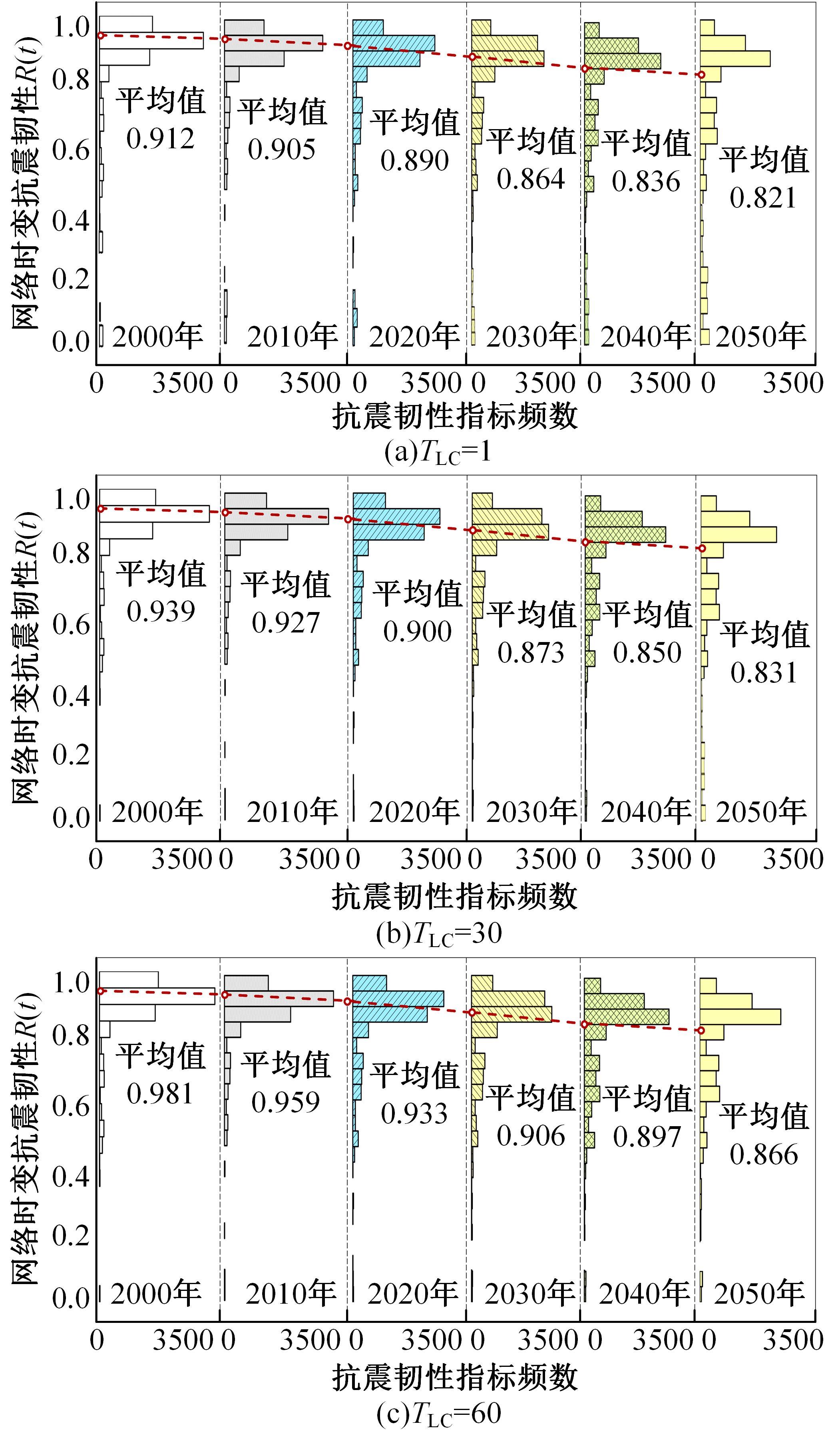吉林大学学报(工学版) ›› 2023, Vol. 53 ›› Issue (6): 1695-1701.doi: 10.13229/j.cnki.jdxbgxb.20221352
• 交通运输工程·土木工程 • 上一篇
数据驱动的公路桥梁网络全寿命抗震韧性评估
刘振亮1,2( ),赵存宝1(
),赵存宝1( ),吴云鹏1,2,马迷娜1,2,马龙双1,2
),吴云鹏1,2,马迷娜1,2,马龙双1,2
- 1.石家庄铁道大学 安全工程与应急管理学院,石家庄 050043
2.河北省大型结构健康诊断与控制研究所,石家庄 050043
Life⁃cycle seismic resilience assessment of highway bridge networks using data⁃driven method
Zhen-liang LIU1,2( ),Cun-bao ZHAO1(
),Cun-bao ZHAO1( ),Yun-peng WU1,2,Mi-na MA1,2,Long-shuang MA1,2
),Yun-peng WU1,2,Mi-na MA1,2,Long-shuang MA1,2
- 1.School of Safety Engineering and Emergency Management,Shijiazhuang Tiedao University,Shijiazhuang 050043,China
2.Structure Health Monitoring and Control Institute,Shijiazhuang Tiedao University,Shijiazhuang 050043,China
摘要:
首先,提出了综合考虑各种因素(网络拓扑结构、桥梁性能退化、地震动等)和不确定性的公路桥梁网络抗震韧性评估框架。然后,分析了网络拓扑结构、桥梁抗震性能和路段功能特点,建立了震后公路桥梁网络时变功能模拟方法。接着,提出了基于人工神经网络的公路桥梁地震易损性快速分析方法。最后,以美国旧金山地区公路桥梁网络为例,采用本文方法分析了地震发生前、后公路桥梁网络的功能变化,据此揭示了全寿命服役期内抗震韧性的演化规律。结果表明,本文建立的数据驱动易损性模型拟合优度可达0.73,可以代替需要大量动力时程分析的易损性分析方法,且公路桥梁网络抗震韧性评估结果准确可靠,可以为防灾减灾提供决策依据。
中图分类号:
- U44
| 1 | Hosseini S, Barker K, Ramirez-Marquez J E. A review of definitions and measures of system resilience[J]. Reliability Engineering & System Safety, 2016, 145: 47-61. |
| 2 | Bruneau M, Reinhorn A. Exploring the concept of seismic resilience for acute care facilities[J]. Earthquake Spectra, 2007, 23(1): 41-62. |
| 3 | Liu Z, Li S, Zhao W, et al. Post-earthquake assessment model for highway bridge networks considering traffic congestion due to earthquake-induced bridge damage[J]. Engineering Structures, 2022, 262: No. 114395. |
| 4 | Ghosh J, Padgett J E. Probabilistic seismic loss assessment of aging bridges using a component-level cost estimation approach[J]. Earthquake Engineering & Structural Dynamics, 2011, 40(15): 1743-1761. |
| 5 | Akiyama M, Frangopol D M, Ishibashi H. Toward life-cycle reliability-, risk- and resilience-based design and assessment of bridges and bridge networks under independent and interacting hazards: emphasis on earthquake, tsunami and corrosion[J]. Structure and Infrastructure Engineering, 2020, 16(1): 26-50. |
| 6 | Xiong C, Huang J, Lu X. Framework for city-scale building seismic resilience simulation and repair scheduling with labor constraints driven by time-history analysis[J]. Computer-Aided Civil and Infrastructure Engineering, 2020, 35(4): 322-341. |
| 7 | Billah M, Alam M S. Seismic fragility assessment of highway bridges: a state-of-the-art review[J]. Structure and Infrastructure Engineering, 2015, 11(6): 804-832. |
| 8 | Jeon J, Mangalathu S, Song J, et al. Parameterized seismic fragility curves for curved multi-frame concrete box-girder bridges using bayesian parameter estimation[J]. Journal of Earthquake Engineering, 2019, 23(6): 954-979. |
| 9 | Nielson B G, DesRoches R. Seismic fragility methodology for highway bridges using a component level approach[J]. Earthquake Engineering & Structural Dynamics, 2007, 36(6): 823-839. |
| 10 | Salehi H, Burgueño R. Emerging artificial intelligence methods in structural engineering[J]. Engineering Structures, 2018, 171: 170-189. |
| 11 | Liu Z, Li S, Guo A, et al. Comprehensive functional resilience assessment methodology for bridge networks using data-driven fragility models[J]. Soil Dynamics and Earthquake Engineering, 2022, 159: No.107326. |
| 12 | Lu X, Xu Y, Tian Y, et al. A deep learning approach to rapid regional post-event seismic damage assessment using time-frequency distributions of ground motions[J]. Earthquake Engineering & Structural Dynamics, 2021, 50(6): 1612-1627. |
| 13 | Dong Y, Frangopol D M, Saydam D. Sustainability of highway bridge networks under seismic hazard[J]. Journal of Earthquake Engineering, 2014, 18(1): 41-66. |
| 14 | Liu Z, Sextos A, Guo A, et al. ANN-based rapid seismic fragility analysis for multi-span concrete bridges[J]. Structures, 2022, 41: 804-817. |
| 15 | 苑溦, 刘振亮, 宗莉娜, 等. 海洋环境下钢骨混凝土桥墩时变抗震性能分析[J]. 南京工业大学学报: 自然科学版, 2020, 42(3): 342-350. |
| Yuan Wei, Liu Zhen-liang, Zong Li-na, et al. Time-dependent seismic performance analysis of steel reinforced concrete bridge piers in the marine environment[J]. Journal of Natural Tech University (Natural Science Edition), 2020, 42(3): 342-350. | |
| 16 | Ghosh J, Padgett J E. Aging considerations in the development of time-dependent seismic fragility curves[J]. Journal of Structural Engineering, 2010, 136(12): 1497-1511. |
| 17 | Baker J W, Lin T, Shahi S K, et al. New ground motion selection procedures and selected motions for the PEER transportation research program[R]. Berkeley, CA: Pacific Earthquake Engineering Research Center, 2011. |
| 18 | Boore D M, Atkinson G M. Ground-motion prediction equations for the average horizontal component of PGA, PGV, and 5%-damped PSA at spectral periods between 0.01 s and 10.0 s[J]. Earthquake Spectra, 2008, 24(1):99-138. |
| 19 | Chen M D, Mangalathu S, Jeon J S. Seismic reliability assessment of bridge networks considering travel time and connectivity reliabilities[J]. Earthquake Engineering & Structural Dynamics, 2022: 51(13): 3097-3110. |
| [1] | 巫威眺,曾坤,周伟,李鹏,靳文舟. 基于多源数据和响应面优化的公交客流预测深度学习方法[J]. 吉林大学学报(工学版), 2023, 53(7): 2001-2015. |
| [2] | 程国柱,盛林,赵浩,冯天军. 基于危险度分析的信号交叉口专用相位设置条件[J]. 吉林大学学报(工学版), 2023, 53(7): 1962-1969. |
| [3] | 何永明,陈世升,冯佳,万亚楠. 基于高精地图的超高速公路虚拟轨道系统[J]. 吉林大学学报(工学版), 2023, 53(7): 2016-2028. |
| [4] | 常玉林,徐文倩,孙超,张鹏. 车联网环境下考虑遵从程度的混合流量逐日均衡[J]. 吉林大学学报(工学版), 2023, 53(4): 1085-1093. |
| [5] | 孙超,尹浩为,汤文蕴,褚昭明. 交通需求估计下的检测器布局和手机数据扩样推断[J]. 吉林大学学报(工学版), 2023, 53(4): 1070-1077. |
| [6] | 贾洪飞,徐英俊,杨丽丽,王楠. 商品车多式联运联盟成员选择及利益分配[J]. 吉林大学学报(工学版), 2023, 53(4): 1060-1069. |
| [7] | 肖雪,李克平,彭博,昌满玮. 基于决策-规划迭代框架的智驾车换道行为建模[J]. 吉林大学学报(工学版), 2023, 53(3): 746-757. |
| [8] | 姚荣涵,徐文韬,郭伟伟. 基于因子长短期记忆的驾驶人接管行为及意图识别[J]. 吉林大学学报(工学版), 2023, 53(3): 758-771. |
| [9] | 王菁,万峰,董春娇,邵春福. 城市轨道交通站点吸引范围及强度建模[J]. 吉林大学学报(工学版), 2023, 53(2): 439-447. |
| [10] | 马敏,胡大伟,舒兰,马壮林. 城市轨道交通网络韧性评估及恢复策略[J]. 吉林大学学报(工学版), 2023, 53(2): 396-404. |
| [11] | 黄文博,陈艳艳,柴树山. 手机信息干预下寒冷赛区行人候车决策行为[J]. 吉林大学学报(工学版), 2023, 53(1): 132-140. |
| [12] | 卢辉遒,赵枫,谢波,田彦涛. 冰雪环境下基于神经网络的驾驶人换道意图识别[J]. 吉林大学学报(工学版), 2023, 53(1): 273-284. |
| [13] | 方松,马健霄,李根,沈玲宏,徐楚博. 城市快速路右侧车道移动作业区行车风险分析[J]. 吉林大学学报(工学版), 2022, 52(8): 1786-1791. |
| [14] | 宋现敏,杨舒天,刘明鑫,李志慧. 站点间公交行程时间波动特性及预测方法[J]. 吉林大学学报(工学版), 2022, 52(8): 1792-1799. |
| [15] | 张玮,张树培,罗崇恩,张生,王国林. 智能汽车紧急工况避撞轨迹规划[J]. 吉林大学学报(工学版), 2022, 52(7): 1515-1523. |
|
||


